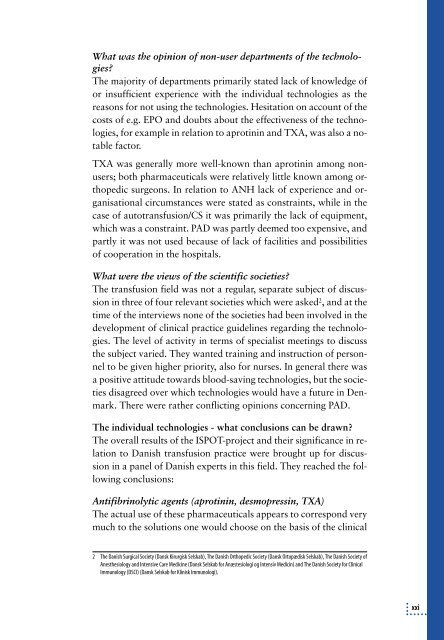Elektronisk udgave - Sundhedsstyrelsen
Elektronisk udgave - Sundhedsstyrelsen
Elektronisk udgave - Sundhedsstyrelsen
You also want an ePaper? Increase the reach of your titles
YUMPU automatically turns print PDFs into web optimized ePapers that Google loves.
What was the opinion of non-user departments of the technologies?<br />
The majority of departments primarily stated lack of knowledge of<br />
or insufficient experience with the individual technologies as the<br />
reasons for not using the technologies. Hesitation on account of the<br />
costs of e.g. EPO and doubts about the effectiveness of the technologies,<br />
for example in relation to aprotinin and TXA, was also a notable<br />
factor.<br />
TXA was generally more well-known than aprotinin among nonusers;<br />
both pharmaceuticals were relatively little known among orthopedic<br />
surgeons. In relation to ANH lack of experience and organisational<br />
circumstances were stated as constraints, while in the<br />
case of autotransfusion/CS it was primarily the lack of equipment,<br />
which was a constraint. PAD was partly deemed too expensive, and<br />
partly it was not used because of lack of facilities and possibilities<br />
of cooperation in the hospitals.<br />
What were the views of the scientific societies?<br />
The transfusion field was not a regular, separate subject of discussion<br />
in three of four relevant societies which were asked 2 , and at the<br />
time of the interviews none of the societies had been involved in the<br />
development of clinical practice guidelines regarding the technologies.<br />
The level of activity in terms of specialist meetings to discuss<br />
the subject varied. They wanted training and instruction of personnel<br />
to be given higher priority, also for nurses. In general there was<br />
a positive attitude towards blood-saving technologies, but the societies<br />
disagreed over which technologies would have a future in Denmark.<br />
There were rather conflicting opinions concerning PAD.<br />
The individual technologies - what conclusions can be drawn?<br />
The overall results of the ISPOT-project and their significance in relation<br />
to Danish transfusion practice were brought up for discussion<br />
in a panel of Danish experts in this field. They reached the following<br />
conclusions:<br />
Antifibrinolytic agents (aprotinin, desmopressin, TXA)<br />
The actual use of these pharmaceuticals appears to correspond very<br />
much to the solutions one would choose on the basis of the clinical<br />
2 The Danish Surgical Society (Dansk Kirurgisk Selskab), The Danish Orthopedic Society (Dansk Ortopædisk Selskab), The Danish Society of<br />
Anesthesiology and Intensive Care Medicine (Dansk Selskab for Anæstesiologi og Intensiv Medicin) and The Danish Society for Clinical<br />
Immunology (DSCI) (Dansk Selskab for Klinisk Immunologi).<br />
xxi

















